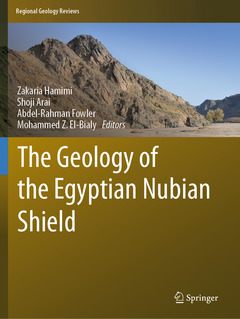The Geology of the Egyptian Nubian Shield, 1st ed. 2021 Regional Geology Reviews Series
Coordonnateurs : Hamimi Zakaria, Arai Shoji, Fowler Abdel-Rahman, El-Bialy Mohammed Z.

Subsequent chapters discuss a broad range of topics, e.g. ophiolite-dominated suprastructural rocks; volcanosedimentary succession, Neoproterozoic volcanism and volcanic rocks in Egypt; enigmatic issues concerning granite, Dokhan and Hammamat sediments; the lithospheric mantle beneath the Northeast African continent and the mantle section of Neoproterozoic ophiolites from the PABE; sutures, megashears and petrogenetic evolution of the Neoproterozoic rocks of Egypt; and metallic and non-metallic mineral deposits in the PABE, which are covered in extensive detail.
The book?s closing chapters discuss the application of remote sensing techniques and anisotropy of magnetic susceptibility (AMS) to decipher the tectonic evolution of the PABE, as well as the use of geophysical data to map structural features and hydrothermal alteration zones in the PABE.
Zakaria Hamimi (Benha University, Egypt)
Zakaria Hamimi is a structural geologist who spent majority of his academic career at Benha University (Egypt) along with some years at Sana’a University (Yemen) and King Abdulaziz University (Saudi Arabia). He has graduated (1984) from Assiut University (distinction with honour degree) and holds the M.Sc. (1988) from Zagazig University (Egypt) and the Ph.D. in Structural Geology and Tectonics (1992) from Cairo University. His research interests focus on structural geology, microstructures and tectonics. He has worked in many field-related sub-disciplines of Earth Sciences including geologic mapping, microstructural analysis, strain analysis, paleostress reconstruction, active tectonics, tectonic geomorphology, crustal deformation and image processing. He used all these fields to study key areas in the Arabian-Nubian Shield and to decipher their deformation history. Zakaria Hamimi is the President and oneof the founding teams, of the Arabian Geosciences Union since 2012. He has received the medal of the Egyptian Geological Society of Egypt in 2015 and also the medal of the Arab Mining and Petroleum Association in 2016. He has co-published 50 research articles in national and international indexed and refereed journals and authored several books. In 2016, Zakaria Hamimi (1) joined the AJGS as Associate Editor responsible for evaluating submissions in the fields of Structural Geology, Microstructures and Tectonics, (2) selected as a Member of the Egyptian Universities Promotion Committee, the Supreme Council for Universities (SCU, Egypt), (3) nominated as a Secretary of the National Committee for Geological Sciences, Academy of Scientific Research and Technology and (4) designated as the IUGS-Representative for Egypt. November 2017, he attended the Gondwana 16 International Conference held at Bangkok, Thailand, as the Representative of the National Committee for Geological Sciences, Academy of Scientif
Date de parution : 10-2021
Ouvrage de 700 p.
21x27.9 cm
Date de parution : 09-2020
Ouvrage de 700 p.
21x27.9 cm



